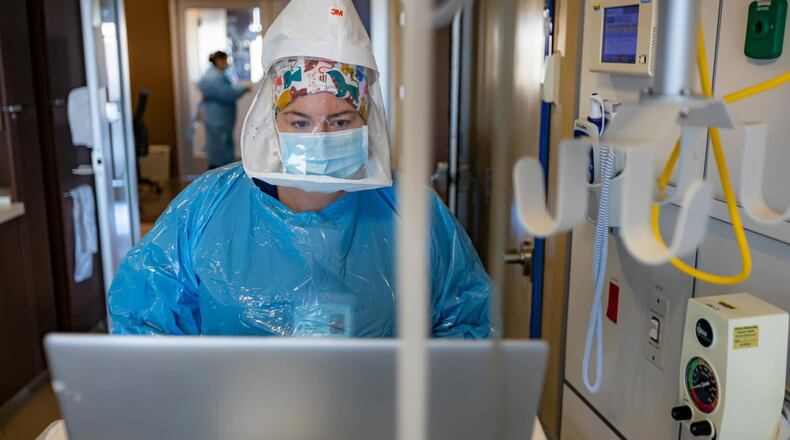GDAHA is asking all these leaders to heed this warning and to help proactively by putting safety protocols back into place if they’ve fallen by the wayside, Hackenbracht said.
“To stem this upward trajectory, we have to put those measures in place now,” she said. “We are calling upon every partner, organization and entity within this region to help us prevent the Dayton region from having the same experience as what the Cleveland and Akron and Toledo communities have had.”
She said northern Ohio’s health systems are being crushed by COVID and our region could soon experience similar levels of patient volumes. Northeast Ohio at its peak reported over 1,700 COVID-19 positive patients. Cleveland Clinic Akron General Hospital was forced to use refrigerated trailers to handle overflow from its morgue.
In the Dayton region, coronavirus cases and hospitalizations are at an all-time high and rising, with unvaccinated residents making up the vast majority of hospital patients and deaths. High case numbers also mean many workers are calling off, frequently disrupting or temporarily closing businesses and essential services. Last week, the region’s largest hospital chains — Premier Health and Kettering Health — announced they would postpone nonemergency procedures that require an overnight stay.
Getting residents vaccinated and taking other precautions can keep businesses open and relieve strain on the region’s health care system, Hackenbracht said.
About 40% of Ohioans, including about 30% of adults, have not received a single dose of the coronavirus vaccine.
Hackenbracht presented to the Dayton City Commission on Wednesday morning and gave similar talks to the region’s city managers and the United Way of the Greater Dayton Area coronavirus work group earlier in the week. Hospital leaders will present early next week to the boards of three major Dayton business associations: the Dayton Area Chamber of Commerce, the Downtown Dayton Partnership and the Dayton Development Coalition. The hospitals are also reaching out to state legislators from the Dayton region.
The hospitals want these organizations to relay the information to others. Hackenbracht said people will hopefully be more receptive to the hospitals’ message if they hear it from someone they know and trust, who is already in their social or professional circle.
Hospitals in the west central Ohio region (Champaign, Clark, Darke, Greene, Miami, Montgomery, Preble and Shelby counties) reported 636 COVID-19 positive patients on Thursday, an all-time high.
During her presentation on Wednesday morning, Hackenbracht pointed to some other alarming statistics.
“Over the last 10 days, the numbers have increased sharply and dramatically,” she said. “We have been working across all facilities to build additional space within our hospitals and increase the number of staffed beds available in our facilities, but unfortunately the number of staffed beds we can provide to the community has limitations at this time.”
During the first five days of January, there were more than 100 COVID-positive patients in ICUs across the region, many of whom were on ventilators, said Hackenbracht. Modeling from the state of Ohio and the Ohio Hospital Association suggests hospital admissions could escalate and peak in the next three weeks, she said.
Last week, 83% of patients hospitalized with COVID-19 at Premier Health and Kettering Health facilities were unvaccinated. In the intensive care units, 89% of COVID patients were unvaccinated.
In the last month, 84% of the 268 COVID-19 patients who died in Premier and Kettering hospitals were unvaccinated.
In response to this, Dayton Mayor Jeffrey Mims Jr. said, “I’m not sure how much more clear the information and evidence can be regarding the importance of being vaccinated.”
Dayton Commissioner Darryl Fairchild, who works at Dayton Children’s Hospital, said hospital staffing seems to be one of the biggest problems, and the region is reaching a critical point when it comes to capacity. Fairchild said he worries that community members’ vigilance is waning because of how long this crisis has lasted. He said people feel helpless and exhausted since there seems to be no end in sight for this crisis.
After hospital administrators brief other business leaders next week, Hackenbracht hopes these associations will pass on the direness of the situation to their members — thousands of the region’s large and small employers.
“We have 2,200 member businesses located across the Dayton region that rely on the chamber for accurate, real-time information on how COVID-19 is and will impact their operations,” said Chris Kershner, the Dayton chamber president. “It is critical that our board hears directly from our health care leaders on the front lines, so our organization and the businesses we represent can make informed decisions.”
Hackenbracht said GDAHA is open to collaborating with any organizations that want to hear more about what’s going on in Dayton’s hospitals.


